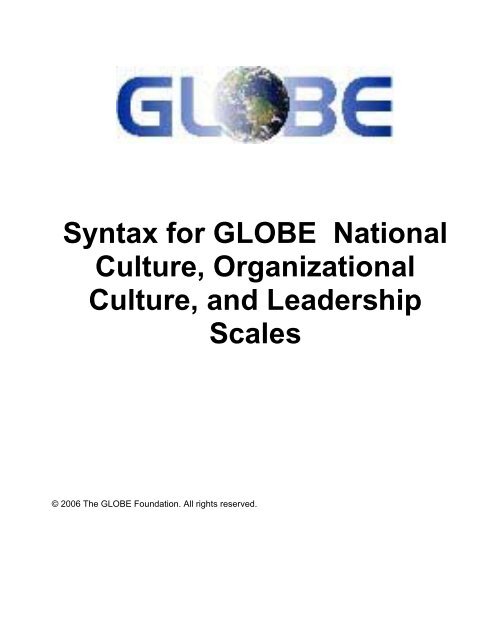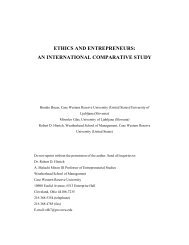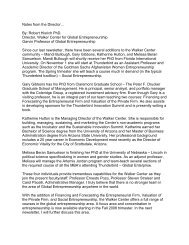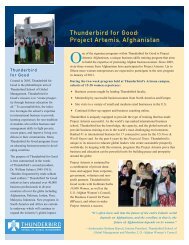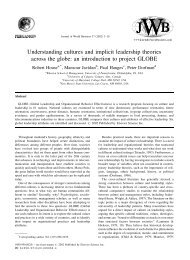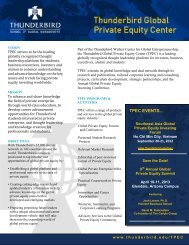Syntax for GLOBE National Culture, Organizational Culture, and ...
Syntax for GLOBE National Culture, Organizational Culture, and ...
Syntax for GLOBE National Culture, Organizational Culture, and ...
Create successful ePaper yourself
Turn your PDF publications into a flip-book with our unique Google optimized e-Paper software.
Team 1: Collaborative Team OrientationTeam 2: Team IntegratorSelf-CenteredStatus ConsciousV4_27V2_30V2_28V2_45V2_3V2_39V4_23V4_38V4_4V2_22V2_25V4_36r2_52V2_23V4_29V2_47V2_38V4_9V4_28NOTE: The item names are interpreted as follows:• The first number represents the section of the <strong>GLOBE</strong> survey.• The second number represents the item within that section. For example, V4_9refers to item 9 in section 4 of the <strong>GLOBE</strong> survey. V2_10 refers to item 10 insection 2 of the survey.Finally, when the item starts with an “r” instead of a “V,” the item should be reversecoded.Thus, r2_52 refers to question 52 in section 2 <strong>and</strong> that this item should be reversecoded.
The Six Second-Order Culturally Endorsed Leadership Scales(Global CLT Scales)1. Charismatic/Value-BasedCharismatic 1: VisionaryCharismatic 2: InspirationalCharismatic 3: Self-SacrificeIntegrityDecisivePer<strong>for</strong>mance-oriented3. Self-ProtectiveSelf-centeredStatus consciousConflict inducerFace-saverProcedural5. Humane-OrientedModestyHumane orientation2. Team-OrientedTeam 1: Collaborative Team OrientationTeam 2: Team IntegratorDiplomaticMalevolent (reverse-scored)Administratively competent4. ParticipativeAutocratic (reverse-scored)Nonparticipative (reverse-scored)6. AutonomousIndividualisticIndependentAutonomousUniqueIt should be noted that dimension 6 (Autonomous) is comprised of questionnaire items, notsubscales. It is considered both a specific subscale <strong>and</strong> global dimension.More specifically, the Global CLT scales were computed by first st<strong>and</strong>ardizing each of the 21first-order leadership scales, creating composite scores by adding the appropriatest<strong>and</strong>ardized scales together, <strong>and</strong> then converting the obtained composite score tounst<strong>and</strong>ardized values by using the classic test theory <strong>for</strong>mulas <strong>for</strong> means <strong>and</strong> st<strong>and</strong>arddeviations of composite scores (see Nunnally <strong>and</strong> Bernstein, 1994).We used the following SPSS syntax statements to create the Global CLT scales.compute zChar_2d=sum(zch1vis,zch2insp,zch3sac,zinteg,zdecis,zperf).compute zTeam_2d=sum(zt1coll,zt2team,zdiplo,zrmalevo,zadminco).compute zNrci_2d=sum(zself,zstatus,zconflic,zface,zproced).compute zPart_2d=sum(zrauto,zrnonpar).compute zhum_2d=sum(zmodesty,zhuman).compute zauto_2d=mean(zautonom).compute Char_2d=((zChar_2d*3.896055/4.62688)+35.09058)/6.compute team_2d=((zteam_2d*2.993195/3.821986)+28.81547)/5.compute nrcis_2d=((znrci_2d*3.66261/3.358717)+16.98613)/5.compute parti_2d=((zpart_2d*1.858398/1.766243)+10.73269)/2.compute hum_2d=((zhum_2d*1.811363/1.695923)+9.709433)/2.compute auton_2d=autonom.execute.
The <strong>Organizational</strong> <strong>Culture</strong> ScalesThe <strong>GLOBE</strong> <strong>Organizational</strong> <strong>Culture</strong> scales are contained in Sections 1 <strong>and</strong> 3 of Form Alpha of the<strong>GLOBE</strong> survey. Section 1 of Form Alpha contains the organizational cultural practice items <strong>and</strong> Section3 of Form Alpha contains the organizational cultural values items.The following SPSS syntax statements indicate the items in Section 1 of Form Alpha of the<strong>GLOBE</strong> survey that need to be reverse-coded:recode V1_1 V1_16 V1_19 (1=7)(2=6)(3=5)(4=4)(5=3)(6=2)(7=1).recode V1_31 V1_3 V1_4 V1_8 V1_13 V1_25 (1=7)(2=6)(3=5)(4=4)(5=3)(6=2)(7=1).recode V1_7 V1_30 V1_9 V1_21 V1_24 V1_29 (1=7)(2=6)(3=5)(4=4)(5=3)(6=2)(7=1).recode V1_15 V1_18 V1_20 V1_27 V1_26 V1_23 (1=7)(2=6)(3=5)(4=4)(5=3)(6=2)(7=1).recode V1_11 V1_33 (1=7)(2=6)(3=5)(4=4)(5=3)(6=2)(7=1).Here is the syntax <strong>for</strong> creating the <strong>Organizational</strong> Cultural Practices (AS IS) scales:Uncertainty Avoidance <strong>Organizational</strong> Practices=mean(V1_1,V1_16,V1_19).Future Oriented <strong>Organizational</strong> Practices =mean(V1_3,V1_4,V1_8).Power Distance <strong>Organizational</strong> Practices =mean(V1_5,V1_13,V1_25).Collectivism 1 <strong>Organizational</strong> Practices =mean(V1_7,V1_12,V1_30).Humane Orientation <strong>Organizational</strong> Practices =mean(V1_9,V1_21,V1_24,V1_29).Per<strong>for</strong>mance Orientation <strong>Organizational</strong> Practices =mean(V1_15,V1_18,V1_20,V1_27).Collectivism 2 <strong>Organizational</strong> Practices =mean(V1_11,V1_23,V1_26,V1_28,V1_33).Gender Egalitarianism <strong>Organizational</strong> Practices =mean(v1_17, v1_22, v1_34).Assertiveness <strong>Organizational</strong> Practices =8-mean(v1_2, v1_6, v1_10, v1_14).The following SPSS syntax statements indicate the items in Section 3 of Form Alpha of the<strong>GLOBE</strong> survey that need to be reverse-coded:recode V3_1 V3_16 V3_19 V3_24 (1=7)(2=6)(3=5)(4=4)(5=3)(6=2)(7=1).recode V3_25 V3_3 V3_4 V3_8 V3_13 V3_26 V3_34 (1=7)(2=6)(3=5)(4=4)(5=3)(6=2)(7=1).recode V3_36 V3_7 V3_28 V3_9 V3_21 V3_32 (1=7)(2=6)(3=5)(4=4)(5=3)(6=2)(7=1).recode V3_38 V3_15 V3_18 V3_20 V3_33 V3_11 V3_23 V3_27 (1=7)(2=6)(3=5)(4=4)(5=3)(6=2)(7=1).Here is the syntax <strong>for</strong> creating the <strong>Organizational</strong> Cultural Values (SHOULD BE) scales:Uncertainty Avoidance <strong>Organizational</strong> Values=mean(V3_1,V3_16,V3_19,V3_24).Future Orientation <strong>Organizational</strong> Values =mean(V3_3,V3_4,V3_8,V3_30).Power Distance <strong>Organizational</strong> Values =mean(V3_5,V3_13,V3_36).Collectivism 1 <strong>Organizational</strong> Values =mean(V3_7,V3_12, V3_40).Humane Orientation <strong>Organizational</strong> Values =mean(V3_9,V3_21,V3_32,V3_38).Per<strong>for</strong>mance Orientation <strong>Organizational</strong> Values =mean(V3_15,V3_18,V3_20,V3_33).Collectivism 2 <strong>Organizational</strong> Values =mean(V3_11,V3_23,V3_27,V3_29,V3_31,V3_37).Gender Egalitarianism <strong>Organizational</strong> Values =mean(v3_17, v3_25, v3_39, v3_41).Assertiveness <strong>Organizational</strong> Values =8-mean(v3_2, v3_10, v3_14).execute.
The Societal <strong>Culture</strong> ScalesThe <strong>GLOBE</strong> Societal <strong>Culture</strong> scales are contained in Sections 1 <strong>and</strong> 3 of Form Beta of the <strong>GLOBE</strong>survey. Section 1 of Form BETA contains the societal cultural practice items <strong>and</strong> Section 3 of FormBeta contains the societal cultural values items.The following SPSS syntax statements indicate the items in Section 1 of Form Beta of the <strong>GLOBE</strong>survey that need to be reverse-coded:recode V1_1 V1_16 V1_19 V1_24 (1=7)(2=6)(3=5)(4=4)(5=3)(6=2)(7=1).recode V1_3 V1_4 V1_8 V1_13 V1_26 V1_27 (1=7)(2=6)(3=5)(4=4)(5=3)(6=2)(7=1).recode V1_34 V1_7 V1_29 V1_35 V1_9 V1_21 (1=7)(2=6)(3=5)(4=4)(5=3)(6=2)(7=1).recode V1_25 V1_32 V1_33 V1_15 V1_18 V1_20 (1=7)(2=6)(3=5)(4=4)(5=3)(6=2)(7=1).recode V1_11 V1_23 V1_28 V1_39 (1=7)(2=6)(3=5)(4=4)(5=3)(6=2)(7=1).recode V1_6 v1_10 v1_14 (1=7)(2=6)(3=5)(4=4)(5=3)(6=2)(7=1).execute.Here is the syntax <strong>for</strong> creating the Societal Cultural Practices (AS IS) scales:Uncertainty Avoidance Societal Practices =mean(V1_1,V1_16,V1_19, V1_24).Future Orientation Societal Practices =mean(V1_3,V1_4,V1_8, V1_30, V1_31).Power Distance Societal Practices =mean(V1_5,V1_13,V1_26, V1_27, V1_34).Collectivism 1 Societal Practices =mean(V1_7,V1_12,V1_29, V1_35).Humane Orientation Societal Practices =mean(V1_9,V1_21,V1_25,V1_32, V1_33).Per<strong>for</strong>mance Orientation Societal Practices =mean(V1_15,V1_18,V1_20).Collectivism 2 Societal Practices =mean(V1_11,V1_23,V1_28,V1_39).Gender Egalitarianism Societal Practices =mean(v1_17,v1_22,v1_36,v1_37,v1_38).Assertiveness Societal Practices =mean(v1_6,v1_10,v1_14).The following SPSS syntax statements indicate the items in Section 3 of Form Beta of the <strong>GLOBE</strong>survey that need to be reverse-coded:recode V3_1 V3_16 V3_19 V3_24 (1=7)(2=6)(3=5)(4=4)(5=3)(6=2)(7=1).recode V3_25 V3_26 V3_3 V3_4 V3_8 V3_13 V3_28 (1=7)(2=6)(3=5)(4=4)(5=3)(6=2)(7=1).recode V3_33 V3_35 V3_7 V3_37 V3_9 V3_21 (1=7)(2=6)(3=5)(4=4)(5=3)(6=2)(7=1).recode V3_27 V3_31 V3_15 V3_18 V3_20 V3_32 V3_11 V3_23 (1=7)(2=6)(3=5)(4=4)(5=3)(6=2)(7=1).recode v3_2 v3_10 v3_14 (1=7)(2=6)(3=5)(4=4)(5=3)(6=2)(7=1).execute.Here is the syntax <strong>for</strong> creating the Societal Cultural Values (SHOULD BE) scales:Uncertainty Avoidance Societal Values=mean(V3_1,V3_16,V3_19,V3_24,V3_25).Future Orientation Societal Values =mean(V3_3,V3_4,V3_8,V3_30).Power Distance Societal Values =mean(V3_5,V3_13,V3_28,V3_33,V3_35).Collectivism 1 Societal Values =mean(V3_7,V3_12,V3_36,V3_37).Humane Orientation Societal Values =mean(V3_9,V3_21,V3_27,V3_31).Per<strong>for</strong>mance Orientation Societal Values =mean(V3_15,V3_18,V3_20,V3_32).Collectivism 2 Societal Values =mean(V3_11,V3_23,V3_29,V3_34).Gender Egalitarianism Societal Values = mean(v3_17,v3_22,v3_26,v3_38,v3_39).Assertiveness Societal Values =mean(v3_2,v3_10,v3_14).


